By Ray Richmond
Are there war stories to be told and shared emanating from the digital filmmaking battlefield? Undoubtedly. But you won't hear too many of them rolling out of the mouths of most directors and cinematographers who have collaborated in the still-infant medium.
Indeed, what is heard most often, at both the October DGA Special Projects retreat on digital filmmaking and in subsequent interviews, are raves: about the portability, the ease, the lighting, the immediacy, the value and — yes — the quality.
Not that it's going to replace 35mm film anytime soon (or ever). But the directors and cinematographer teams we interviewed speak of the harmony bred in part by the technology of digital cinema itself. There are cons, to be sure; however, the pros of the experience tend most often to dominate.
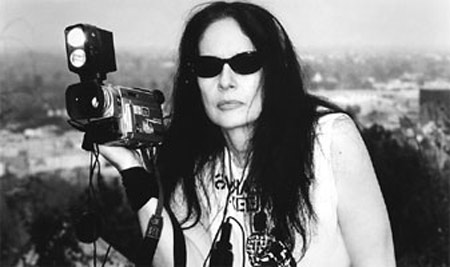
Director Penelope Spheeris
Jeff DeVuono worked as DP with director Penelope Spheeris on the 2001 feature-length, high-definition/mini-digital video documentary, We Sold Our Souls for Rock 'n' Roll, which followed the 2000 Ozzfest Tour. Shooting the film on HD and DV made for a completely different experience, DeVuono recalls, one that allowed for greater flexibility in a decidedly guerilla-type filmmaking situation.
"The portability of the medium allowed us to leapfrog between stages at these concerts, running back and forth with our camera crews," DeVuono says. "The biggest advantage with digital is just the physics of things. You have so much less physically to deal with. It's a matter of having a 40-minute cassette vs. a huge camera and a couple of magazines to lug around. Penelope wound up recruiting these two huge kids to run interference for us. We were actually able to get into the mosh-pit swarm with the cameras. And the only reason that was even possible was that we used a HD camera rather than a film one."
"The studio process for making films is a very cumbersome way to make movies," Spheeris says. "I've done several different documentary projects in DV and HD, and it was a liberating experience. I was able to shoot 270 hours of digital tape." And after viewing the results on HD projection, she feels, "It changed my life and my perception of what my role was in filmmaking."
One of DeVuono and Spheeris' most memorable days on the shoot happened when the Ozzfest tour moved through Phoenix. "It was like 110 degrees, and the crowd was extremely rowdy. So it gets to be nighttime, and the crowd literally attacks us. We see two bonfires up on the hill in the lawn section. And Penelope says, 'Let's go up there.' I'm like, 'Excuse me? Wait a second. I have a quarter-million dollars worth of equipment here. And all I see is a bunch of drunk people.'
Director Debbie Allen on the set of The Old Settler
"So Penelope asks, 'Is it insured?' I tell her, 'Yeah.' So she says, 'Follow me.' I'm like, far out! I would follow Penelope Spheeris into hell. And that was about as close to hell as I'm likely to get for a while."
One cinematographer who has had a decidedly less chaotic experience with HD and DV is John W. Simmons, who served as DP on a trio of stage-inspired films for public broadcaster KCET: The Old Settler (with director Debbie Allen), Collected Stories (directed by Gilbert Cates based on his 1999 award-winning play of the same name) and most recently, The Gin Game (directed by Arvin Brown). All three pictures were shot in HD, making Simmons something of an expert on the emerging technology and its differences from conventional film.
"I was really lucky with these three directors, as it turns out," Simmons recalled. "Every one of them had a definite idea of what they wanted to do and how they wanted the pictures to look. It's fun when the director is willing to work around the misconception that HD doesn't require as much lighting. That's simply not true. The lighting is simply different. It tends to reveal more. And you don't have as much latitude with it as you do with film. It doesn't handle the bright areas as easily as film does. You have to work to create your shadows."
Optically, adds Simmons, HD offers a greater depth of field. He notes that, "directors are always blown away by" how far they have to pull back the camera to get a close-up.
"The other thing is, I personally never strive with HD or digital to make it look like film," Simmons says. "I just work to make it look good. Because it's a hybrid medium. To exploit everything it has to offer — such as its greater immediacy — is a wonderful thing in itself."
Cates, who worked with Simmons on reprising Collected Stories, called his DP "a genius" for his efforts on the movie that starred Linda Lavin and Samantha Mathis. He was greatly pleased with the way the HD shooting treated his creation.
"I really basically wanted to see what the new technology was like," Cates says, "I knew the finished product was going to air on television so it seemed appropriate to film it in HD rather than shooting on film and transferring it to HD. I could find no disadvantage to it qualitatively and a lot of advantages creatively. The ease of facility in the hand-held tape mode is wonderful, and the quality of the pictures extraordinary."
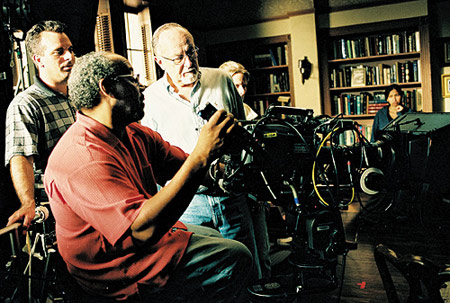
DGA Secretary-Treasurer Gil Cates (right) with cinematogapher John Simmons discussing Collected Stories
What does it look like? "It looks like its own thing," Cates believes. It's better than tape and not quite like film. But it's more real than film."
Would he direct in HD again?
"Absolutely," Cates replies, "and I haven't met anyone who worked in the medium who wouldn't do it a second time."
Wholeheartedly confirming that assessment is Debbie Allen, who directed the 2001 production of The Old Settler with Simmons.
What surprised Allen initially was how much the shooting techniques differed from what she was accustomed to with a hard 35mm or 16mm film camera. "It looks like the HD camera has aliens hanging off the sides. There are all of these wires. It's also much smaller. But it's so versatile. There's still nothing like 35. It's the bread and butter. But HD is so cost-effective. With budget constraints, it's great. And it really looks good. It's amazing how much it looks like film."
But, like Cates, Allen feels it isn't really like working with film at all. She points out how digital can be manipulated in post-production in ways that film cannot.
"On the down side, you really need your technician there at all times to balance things," Allen says. "It requires extra time with the light. It has to be projected exactly right or you wind up having things moving around. But when push comes to shove, no matter what you're working in, it's still all about your actors. Your medium doesn't change the performance. And you can never undersell the human factor."
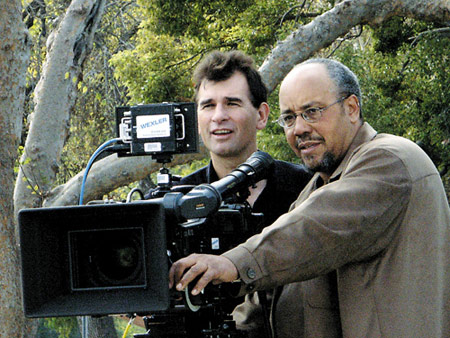
Bryan Johnson and Simmons
Arvin Brown, who directed Gin Game in HD format in tandem with DP Simmons, raves about trusting his cinematographer's experience and his eye to guide him through his maiden digital voyage.
"In fact, I'd say one thing that's interesting about the digital process is the absolute sympatico that's required with your technical crew in order to succeed at the highest level," Brown says. "Your camera operator has to have a real understanding of the dramatic process. I can't imagine what shooting like this would be like if the technicians' personalities are not sensitive to what's happening dramatically."
The fact that Gin Game — like Collected Stories and The Old Settler before it — was shot on a tight 12-day schedule made every second and every take count. And that made HD a winner in Brown's book.
"With tape, you're not reloading nearly as often, and when you do it's very fast," Brown says. "We had the luxury of being able to do two or three takes in a row of very long scenes without having to reload the camera. And that was a key advantage. In terms of performer vitality and keeping the momentum going, it was terrific. You could go back in right away with an emotional scene.
"The other thing is, I love the look of it. I think HD is just beautiful. There was a problem initially with flatness of the lighting and everything getting an equal focus. But Johnny (Simmons) handled that brilliantly. He gave the visual a real texture. He takes a 'painter-ly' approach to the medium that's really quite extraordinary."
Indeed, the lighting issue is one that remains a sticking point to directors and cinematographers alike working in HD and DV. Bryan Johnson, who worked with Simmons, directed a live concert featuring the musical artist Eve as well as several commercials, maintains that while the quality is consistently solid, lighting control can illuminate bugs in the system.
"Shooting outside in broad daylight, digital is not going to look like film," Johnson emphasizes. "I don't care what people tell you. It's a bit like using a Phillips head screwdriver and a flat head. If you have a flat head and you need a Phillips, it's really hard. If you have the Phillips, it comes out easily. When you use HD in the right situation, it runs smooth as silk. But lighting is something that must be carefully monitored."
Steve Poster, President of the American Society of Cinematographers (ASC), looks at digital as "another way to paint a picture." But he doesn't believe it's the be-all and end-all that some have made it out to be.
"Where it's viable, it's terrific," Poster believes. "Our official attitude at the ASC is that we're exploring where it can be used to its most effective outcome. A lot of people have tried to paint us as being afraid of the technology. It's just not true. To me, it simply makes sense to embrace this tentatively. It's a work in progress. The problem was it was oversold and it was hyped not only by Sony but also by a media that is so enamored of anything digital.
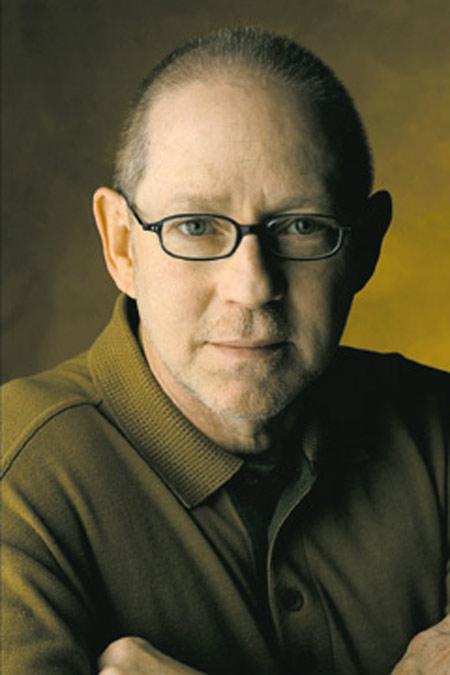
ASC President Steve Poster
"So when filmmakers were told that they don't have to have light, they don't have to have crews, they don't need any money, they can just be one guy going out and making a movie...well, everyone wanted to believe it initially. It can be a viable technology for the right uses. But we're not afraid of it or negative about it."
Neither is Rodrigo Garcia, director of the 2001 digital feature Ten Tiny Love Stories which consists of 10 short monologues delivered in direct-to-the-camera address by actresses including Elizabeth Pena and Kathy Baker.
Garcia decided to shoot his film in HD so he could shoot each monologue nonstop, without cuts, which would have been impossible on 10-minute film magazines, since some of the monologues stretched to 15 minutes. He also wanted the look to denote something "a little bit ambiguous," so it would be unclear whether what people were seeing was a series of documentary interviews or something that was written, then rehearsed and played by an actor. Using a Panavision HD camera satisfied all of his needs: creative, logistical and financial.
"There was literally no disadvantage for me shooting it this way," Garcia says. "Using a film camera would have been bulkier and more cumbersome. Digital and HD cameras are getting small and smaller. It's very comfortable to grab the camera and shoot from the hip, as it were. But I don't think it works for every project. It really all depends. You have to go on your instincts. Some things are better with film, some with digital, still others digital transferred to film."
In shooting his 2002 feature Chuck & Buck (which premiered at the Sundance Film Festival) on a pair of VX-1000 cameras, director Miguel Arteta feels like he had to sacrifice something in terms of the film's depth of field. He believes, "There's something poetic about the depth of field you get in a film image. It's positively lyrical. And you always want that poetic quality."
On the other hand, he found the digital advantages far outweighing the disadvantages.
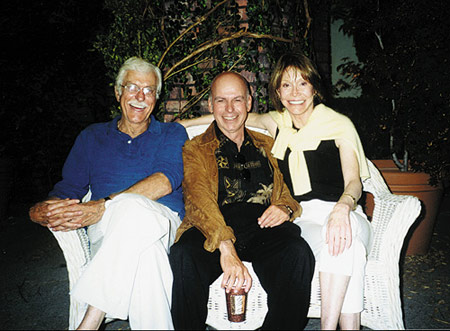
Dick Van Dyke (left), Arvin Brown and Mary Tyler Moore from The Gin Game
"I could get as close to the actors as I wanted to," Arteta recalls, "and that seemed to take a lot of the pressure off of them. It's a lot different when you're dealing with a five-pound plastic object instead of a 30-pound metal one. It's informal and casual by nature. It puts the emphasis on the performances instead of the equipment and is far less intimidating. There is an immediacy and intimacy you never find with film. In the middle of a take, if my DP didn't like the angle, even if it was on a tripod, he could pick up the whole thing and move it while the actors were talking. You could never in a million years do that with a 35mm camera."
Arteta also believes that digital has caused greater communication between director and cinematographer, calling it "a wonderful excuse for independent filmmakers and cinematographers to share information and ideas. So it has really benefited the community. I wound up having quite an intuitive relationship with my DP, Chuy Chavez, on Chuck & Buck. All I had to do was look at him, and he knew I wanted him to move the camera. This medium definitely encouraged both of us to take more chances."
On the other hand, Arteta cautions that too much shouldn't be made of the digital equipment itself in forging a film revolution, since his feeling is it's "not about the camera per se but the freedom it affords. You can be shooting films on toilet paper as long as your emphasis is in the right place, like originality and good characters. Nobody is going to go see a film simply because it was shot in HD."
On the other hand, certain films stand to be made solely because of the relatively lower costs afforded by working in digital. Arteta stresses how digital technology has significantly lowered the entry fee to feature filmmaking, noting that Chuck & Buck was put in the can for around $250,000.
"By the time it got to Sundance, it had cost just under $500,000 including post-production," Arteta says, "and you can do a movie for a lot less than that even."
Speaking at a DGA retreat in October, director Allison Anders, who shot her 2001 feature Things Behind the Sun in HD, points out that the low cost of the format truly does place control back into the hands of the filmmaker. "If you have a camera and an editing system, you can make a film so cheaply that it provides a protection to be able to tell stories that someone else might consider too dark or soft or edgy or whatever. Whoever makes that decision always has the money hanging over your head. In this medium, you have the independence to tell that story."
Another advantage to Anders' mind is the simpler language of digital. "With film, I always felt like it was some other language and I couldn't speak it," she admits. "But with digital, Final Cut Pro, and color correction, it's so easy for me to speak the language. It's just an easier kind of technology — something I understand. Film was an old language that I was never going to get a handle on. It was so entrenched and rigid. I had to leave it in the hands of my DP. Not with digital."
And while many will dispute the aesthetic similarities between digital and film, DeVuono maintains that the differences are minute. "Only fools still cling to the belief that digital video sports vastly inferior quality," he believes. "I equate it to the difference between oil-based and water-based paint. They're similar and yet quite different. And each has terrific applications. So to compare them on an apples to apples basis doesn't do either one justice."
Nevertheless, people do — and will continue to do — just that. From what DeVuono has seen over the years, the results of any side-by-side comparison "tend to depend on who is sponsoring it. If it's sponsored by a video manufacturer, it's deemed to be exactly the same. If it's someone with a film bias, then that obviously comes into play."
DeVuono notes that We Sold Our Souls For Rock 'n' Roll carried about a $1.2 million price-tag, a modest sum for such a mammoth undertaking. It's one of the many reasons why he wants to continue working in digital into the future.
"The best thing about it is that so many more people can make films," he says. "Film isn't just the boys' club anymore. Anybody with a couple of thousand dollars can make a movie. It may not be the best movie, but it opens up that door."